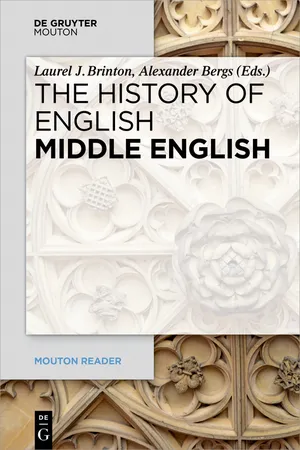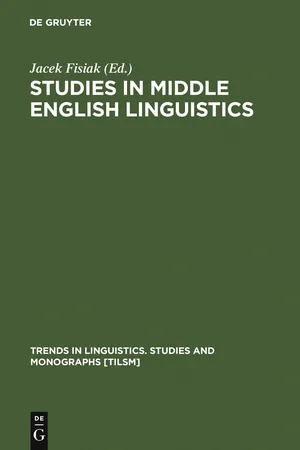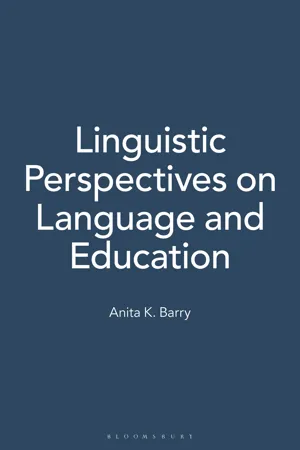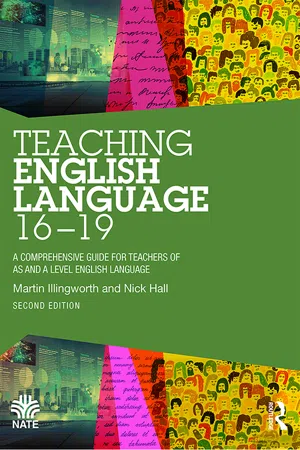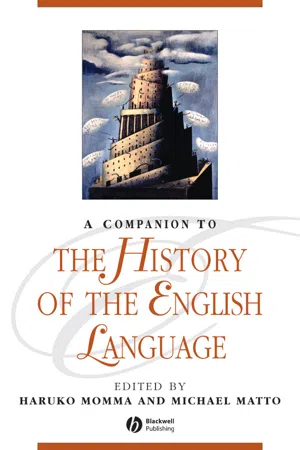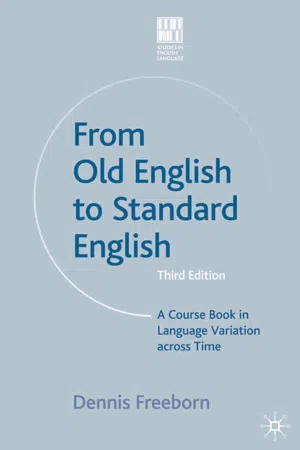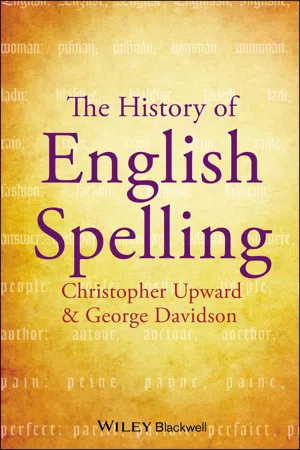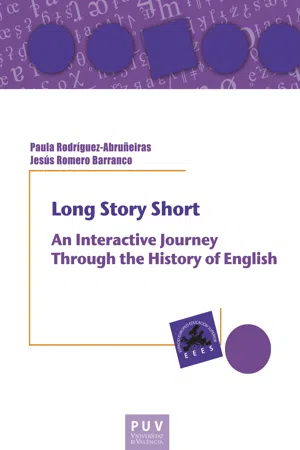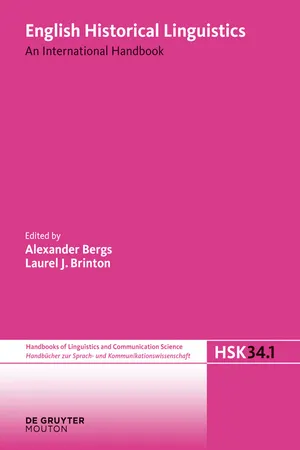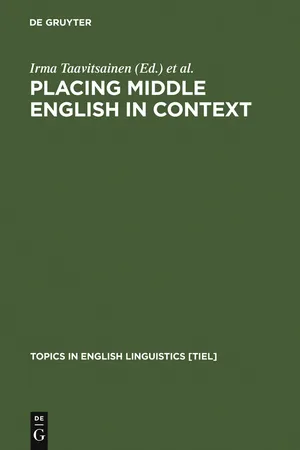Languages & Linguistics
Middle English
Middle English refers to the stage of the English language spoken from around 1100 to 1500 AD. It developed after the Norman Conquest and was characterized by significant changes in grammar, vocabulary, and pronunciation. During this period, English absorbed a large number of French and Latin words, leading to a rich and diverse linguistic landscape.
Written by Perlego with AI-assistance
Related key terms
1 of 5
12 Key excerpts on "Middle English"
- eBook - ePub
- Laurel Brinton, Alexander Bergs, Laurel Brinton, Alexander Bergs(Authors)
- 2017(Publication Date)
- De Gruyter Mouton(Publisher)
Jeremy J. Smith Chapter 2: Middle English: Overview Jeremy J. Smith: Glasgow (UK) 1 What is Middle English? 2 Issues of evidence 3 Writing and speech 4 Grammar 5 Lexicon 6 Summary 7 References Abstract : Middle English is the period in the history of English when variation is most thoroughly recorded in the spoken mode, and the body of surviving material is very large. In this chapter, the extralinguistic reasons for the survival of variation in Middle English are given, focusing on the relationship between linguistic form and socio-cultural function. Middle English has come down to us directly through manuscripts, and indirectly through reconstruction and through the study of residualisms in Present-day English; the reliability of the evidence for Middle English is assessed. Each level of language in turn is then discussed: writing- and speech-systems (= transmission), grammar, and lexicon. New resources (especially online) for the study of Middle English are flagged, offering exciting possibilities for future research. The aim of the chapter is to offer both a characterization of Middle English itself and a sketch of the resources available for its study. 1 What is Middle English? Middle English (ME) is the form of English spoken and written roughly between 1100 and 1500 CE. Its beginning roughly corresponds to the Norman Conquest of 1066, while its end roughly corresponds to the first book printed in English (1475) and the arrival of printing in England (1476): these two historical events, though of very different kinds, have implications for the status of the language during the Middle English period. Up until the Norman Conquest, English (i.e. Old English) had a distinct status as a language of record and for literary expression; it developed a written standardized form, classical Late West Saxon, which was used by scribes outside its area of origin, i.e. Wessex in south-west England - eBook - PDF
- Jacek Fisiak(Author)
- 2011(Publication Date)
- De Gruyter Mouton(Publisher)
When did Middle English begin? Later than you think! Peter R. Kitson One of the aspects of Middle English about which there has been least general agreement is when it began. Partly this depends on how exactly you define the periods of English. Henry Sweet in his pioneering classifi-cation (1874: 157-161) was very clear about this. To him Old English is the period of full inflections ( nama, gifan, caru ), Middle English of levelled inflections ( naame, given, caare) (1874: 160). It is plain from his example and his preceding discussion (1874: 52; cf. 29-30, 55-56) that what he meant was the existence or not of a variety of vowels in un-stressed inflectional syllables. Of course the loss of variety was not in-stantaneous. Sweet's first History offers no exact chronologies except for Modern English (1874: 56), but he has a good deal to say about the linguistic processes of the transition from Old to Middle (1874: 38-40), implying that it took a substantial period; he refers roughly (1874: 39) to the Transition English of the twelfth century. By the time of his New English Grammar he had schematized that, giving Late Old English 900-1100, Early Middle English 1200-1300, and Transition Old Eng-lish the whole century 1100-1200. In keeping with his definition, he characterizes the language of Lajamon, in which some variety of inflec-tional vowels remains, as not Early Middle but Transition Old English (1892: 211). More recent writers have tended either to prefer a tidy join between Old English and Middle English, or at least to shorten the transi-tional period if they allow one, and put the start of Middle English earlier. Sweet himself in the second edition of his History gave them their lead. There he dates fully developed ME ... from 1150, while The period from 1050 to 1150 may be distinguished as Old Transition (1888: 154). We should note that this was four years earlier than the New English Grammar, and is inconsistent in its treatment of La3amon, whose older ms. - eBook - PDF
- Thomas Kohnen(Author)
- 2014(Publication Date)
But it also might lead to a mixture of dialects since people from different parts of the country, speaking vastly differing regional varieties, met and might live in close proximity, especially in London during the fifteenth century. In the course of time, certain dialect features could be levelled and an incipient local standard could form (on standardisation see Chapter 4.2.5.). In the second half of the fifteenth century, towards the end of the Middle English period, English thus emerged as the dominant medium of communication in all important domains of language use, both spoken and written. 4.2. Language structure 4.2.1. Spelling and pronunciation One of the most noticeable, if not notorious, features of Middle English is its extraordinary diversity of orthography. Basically, there is hardly any word which is spelt in an identical way in the period, and the variant spellings of one 77 item sometimes go beyond twenty. For example, the glossary of the collection of early Middle English texts edited by Bennett and Smithers (1968) lists no less than 22 different variants for “noút”, with the senses “nothing” and “not at all, not”. These are: (1) noZt, nouZt, nouúth, noht, noght, nohht, nocht, nogt, noth, nout, nouth, nouct, nohut, novt, nawt, nowt, nowth, naht, nacht, nauúth, nowiút, noouiút (Bennett and Smithers 1968: 540) This almost chaotic heterogeneity of Middle English spelling can be explained by three major factors. Firstly, we find that, especially in the century following the Norman Conquest, scribes still kept copying Anglo-Saxon texts and thus followed the Old English writing traditions, although at least some of the sounds were changing. Secondly, as a long-term consequence of the Norman Conquest, we witness new, Norman-French conventions which are introduced in manuscripts produced in England. Thirdly, and quite importantly, Middle English is the period of dialectal diversification of the written language. - Anita K. Barry(Author)
- 2002(Publication Date)
- Praeger(Publisher)
700 the island was Chris- tianized. During these years, too, England weathered repeated invasions from certain Scandinavians, known then as the Danes or the Vikings, who at one point had virtually conquered the country. Through the able leadership of King Alfred the Great, England rebounded and in A.D. 878 negotiated a treaty with the Vikings that would permit the Scandinavians to live under their own rule in the northeastern part of England in an area known as the Danelaw. They settled in peacefully and, not being very different either in language or culture from the English, soon merged into the population. The period of Old English lasted until 1066, a major turning point in the history of the English language. King Edward the Confessor of England died without an heir to the throne. William, Duke of Normandy, believed that he was entitled to the throne, but instead Harold was elected king. In the famous Battle of Hastings in 1066, William and his troops invaded England and killed Harold with an arrow through the eye. William then declared himself King of England and has been referred to since that time as "William the Conqueror." What makes this event linguistically significant is that Normandy was part of France and William spoke French, not English. This fact, as we shall soon see, was to have a profound effect on the development of English from that point on. The period of English between 1066 and 1500 is known as Middle English. The period known as the Modern English period begins in 1500, the point at which English is recognizable to us as our language. The three periods of English are illustrated below in excerpts from the Lord's Prayer from each period. As you can see, Old English looks as foreign to speak- ers of Modern English as any foreign language might. Middle English is more recognizable but still not similar enough to be understood by speakers of Modern English.- eBook - ePub
Teaching English Language 16-19
A Comprehensive Guide for Teachers of AS and A Level English Language
- Martin Illingworth, Nick Hall(Authors)
- 2018(Publication Date)
- Routledge(Publisher)
As well as these ‘internal’ features of the texts of Old English, you could discuss with your group how they feel about having become detached from the origins of their language. I would suggest that most merely feel that it is mildly irritating not to be able to read texts in museums. It perhaps makes the past feel even more distant and strange. You might reflect with your class upon the plight of languages which are becoming extinct, subsumed by bigger languages like English. For example, the last speaker of the language Kasabe, spoken in Cameroon, died in November of 1996 before the language had been documented by linguists (there are many languages in the world that do not have a written form). It would surely be more than ‘mildly irritating’ if that speaker were a relative of yours and he took with him all of your family history. Languages are the repositories of history, the gateposts to identity and cultural understanding.Middle English Period 1150–1500AD
The Canterbury Tales , Geoffrey Chaucer. Chaucer is an important writer for linguistic study because of the sheer range of voices portrayed in his choice of characters on their pilgrimage to Canterbury from London. Chaucer chose his characters from all walks of life and they bring with them the multiplicity of accents, dialects, high-brow foreign borrowings and earthy Anglo-Saxon vocabulary.The Lord’s Prayer . It can be useful to contrast your Old English version of The Lord’s Prayer (above) with a Middle English version. This makes a good introduction to the ways in which the language has moved on between the two general time periods. Students will undoubtedly note that this text is much more accessible. So, you explore why they can now, not only identify the text, but fully understand it.Oure fadir that art in heuenys, Halewid be thy name. Thy kingdom come to, Be-thy wille don as in heuene an in erthe. Give to us this day oure breed ouer other substaunse, And furgiue to us oure dettouris, And leede us not into temptacioun, But delyuere us from yuel. Amen.Piers Plowman , William Langland. In a period when the English language had made extensive borrowings from French, Langland’s verse is notably lacking in such borrowings. This text deals with the plight of the working classes of the Midlands area and is written in alliterative verse making use of the voice of the peasant classes. For the linguist, this text is a good reminder that each text must be considered on its own merits rather than general notions of what one might expect to see in a text written in 1390.__________________________________This period is dominated by the invasion of the Norman French in 1066. English became a second-, or indeed third-class language in its own country behind the French of the ruling classes and the language of learning and religion, Latin. Writing in English all but disappears after the Norman Conquest until around 1200. English became an oral language, not thought fitting for serious and important matters. - Haruko Momma, Michael Matto, Haruko Momma, Michael Matto(Authors)
- 2009(Publication Date)
- Wiley-Blackwell(Publisher)
With the arrival of the Normans, the ruling class of England became predominantly French speaking. English, though still spoken by the majority of the population, occupied the lower tier of the language pyramid. Confined to local function with limited usage, written English now reflected regional speech and relied on individual talent unbridled by regularization from higher authority. When England became politically isolated from the Continent in the thirteenth century, however, more and more members of the ruling class turned to the insular vernacular. Consequently English was placed under French influences, absorbing Romance vocabulary and experimenting with continental poetic forms. The Gallicism known as the polite ye – in which second-person plural forms ( ye , you , etc.) were used for the second-person singular (instead of þou , þe , etc.) to register deference – spread with remarkable rapidity and consistency (see early Middle English ). The cultural history of Middle English is a history of elaboration through which the language responded to the demand for a greater social application. Chaucer’s reputation as a distinguished English author among his contemporaries and near contemporaries may largely come from his rhetorical elaboration upon the vernacular (see varieties of Middle English ; also chaucer’s literary english ). In the late Middle English period a written standard began to develop in the metropole, where the original regional dialect was constantly modified by the dialects of new migrants. Writing in London during the late fourteenth century, Chaucer showed sensitivity to the way his work was copied by his scribe. During the earlier decades of the fifteenth century, a new London dialect was cultivated at Chancery for the production of governmental documents.- eBook - PDF
From Old English to Standard English
A Course Book in Language Variations Across Time
- Dennis Freeborn(Author)
- 2017(Publication Date)
- Red Globe Press(Publisher)
5 From Old English to Middle English 5.1 The evidence for linguistic change The ways in which we have identified and described features of the language in the Old English texts in Chapters 1–4 are those that we can systematically apply to any text of English. We look for: ● Changes in spelling conventions, letter forms and the alphabet used. These are our only guide in OE and ME texts to the pronunciation of the language. ● Changes in pronunciation , inferred from the written words. ● Changes in word structure , suffixes (inflections) and prefixes. ● Changes in the grammar and word order. ● Changes in the word-stock or vocabulary – new words appear, old ones are no longer used. We call the language from about 1150 to 1450 Middle English (ME), because from our point of view in time it comes between the periods of Old and Modern English. The evidence for change and development in ME, before the first printing press was set up by William Caxton in 1476, lies in written manuscripts, just as for OE. Every copy of a book, letter, will or charter had to be written out by hand, but only a few of the existing manuscripts in ME are originals, in the hand of their author. Many copies of a popular book like Chaucer’s Canterbury Tales , for example, have survived, though Chaucer’s original manuscripts have been lost. On the other hand, other works are known through a single surviving copy only. As a result of the social and political upheaval caused by the Norman Conquest (see section 5.2, following), the West Saxon standard system of spelling and punctuation was in time no longer used. Writers used spellings that tended to match the pronunciation of their spoken dialect. Scribes often changed the spelling of words they were copying to match their own dialectal pronunciation. After several copies, the writing might contain a mixture of different dialectal forms. - eBook - ePub
- David Graddol, Dick Leith, Joan Swann, Martin Rhys, Julia Gillen, David Graddol, Dick Leith, Joan Swann, Martin Rhys, Julia Gillen(Authors)
- 2020(Publication Date)
- Routledge(Publisher)
Englisc ('English') was first used to denote both people and language under his auspices.In the tenth century there was another revival of learning and literary activity, this time associated with the influential Benedictine monasteries. The scriptorium of the monastery at Winchester, producing texts in the West Saxon dialect, seems to have made considerable efforts to regularise spellings and this has been seen as a move in the direction of standardisation in English. (See another book in this series, Graddol et al, 2007, for further discussion of this issue).Most extant Old English manuscripts date from the late Old English period and they preserve, not only translations of learned Latin texts, but also an important body of vernacular literature in prose and poetry. Some of the poems are religious, following the example set by Caedmon, and others (such as Beowulf) stem from inherited Germanic traditions.So far we've looked at Old English: where it came from, what it was like, how certain aspects of it changed, and how the process of change might be explained. We now move on to a different period of the English language, that known as 'Middle English'.2.6 The transition to Middle EnglishWe have seen that the English language was undergoing significant change during the early part of the tenth century. In 1066 an event occurred that was to have a profound effect on this process. In that year a French-speaking dynasty from the dukedom of Normandy was installed in England. This external event has long been seen as decisive, not only for the history of England (and consequently Britain) but for the English language as well. For scholars who have viewed the history of England and English as one of unbroken progress, the Conquest has often been a milestone on the road to 'civilisation', playing a key role in the development of Modern English. But another view, perhaps more widely held, sees the events of the Conquest in terms of (an at least temporary) decline: as the wrecking of a relatively sophisticated 'native' Anglo-Saxon culture by a 'foreign' and tyrannical French one, so that the continuity of English culture was ruptured and the continued existence of the English language threatened. - eBook - ePub
- Christopher Upward, George Davidson(Authors)
- 2011(Publication Date)
- Wiley-Blackwell(Publisher)
We must now turn our attention back again briefly to England before and after the arrival of the Normans. By the late 9th century, the kingdom of Wessex under King Alfred had achieved a dominant position in Anglo-Saxon England, and in the period before the Norman Conquest, the West Saxon dialect of Wessex (or something very close to it) had come to be accepted as the standard written form of English. While local dialects were still spoken in Wessex and elsewhere, and were without doubt undergoing changes in grammar and pronunciation (Old English did not suddenly change into Middle English in the mid-12th century), most English writings of this period conform to this West Saxon written standard (though there is evidence of other standards). After the Norman Conquest, however, as English was replaced by French and Latin as the languages of officialdom, West Saxon increasingly lost its position of linguistic prestige and became merely one of several Middle English dialects of equal status. It is for this reason that most 12th-century writings appear quite different to those of the 10th or 11th centuries. In 12th-century writings, writers show changes in the language that had almost certainly already occurred in the spoken language late in the Old English period but of which there are only occasional traces in the writings of the time, standard written languages tending to remain conservative and conventional and slow to acknowledge on-going change in the spoken language (a phenomenon we will encounter again in the late Middle English and Early Modern English periods; see Chapter 6).In Middle English, no one dialect had the prestige to dominate over the others. Middle English writers, unlike their Anglo-Saxon predecessors, customarily employed whichever form of English they spoke, and scribes who copied their work either preserved the original form of language or else more or less consistently substituted their own local forms. Writing about 1385, Chaucer writes in Troilus and Criseyde of the ‘gret diversité in Englissh’. What gives rise to this ‘diversité’ is the absence of any accepted national standard for written English in the early part of the Middle English period.The absence of a national written standard means that the same word may be spelled in a variety of ways. However, the writing of Middle English was by no means totally uncontrolled: individual scribal training centres seem to have taught their own spelling rules, and the usage of a scribe can often be shown to be quite strictly determined by the practice of a local school. But the usage of the schools prevailed only in particular areas and for limited periods of time, and in general there is a good deal of inconsistency in scribal writings. - eBook - PDF
Long Story Short:
An Interactive Journey through the History of English
- Paula Rodríguez Abruñeiras, Jesús Romero Barranco(Authors)
- 2021(Publication Date)
- Publicacions de la Universitat de València(Publisher)
4.2. THE CONSTRUCTION OF Middle English ISOGLOSSES AND THE EMERGENCE OF A NEW STANDARD Variation in the Middle Ages was notorious from different standpoints: level of linguistic analysis (morphology, phonology, syntax, etc.), geographic area and date of composition (“texts from different areas are different, and later texts differ very markedly from earlier ones”, Milroy 1992: 156). Before the invention of the printing press, copies of the same text were made by scribes in different parts of England, and those scribes would capture the main linguistic features of their own variety of English in their production. Five main ME varieties can be distinguished up to the emergence of a standard in the 15 th century. From least to most conservative these are Northern, West midland, East Midland, Southern and Kentish. The different dialects spoken in England were not always mutually intelligible, and speakers would usually regard theirs as the superior variety, as can be seen in the passages below: Excerpt 3. Cursor Mundi , by Richard Morris ( Corpus of Middle English Prose and Verse ; https://quod.lib.umich.edu/c/cme/AJT8128.0001.001/1:4.1.128?rgn=div3;view=fulltext) ME In sotherin englis was it draun, And turnd it haue i till our aun Word by word translation (our own) In southern English it was written And translated have I to our own Scan the following QR code to see a map of ME dialectal areas (also available at https://historyofenglishpodcast.com/2018/06/08/episode-112-northern-messenger/) Long Story Short: An Interactive Journey thorugh the History of English 101 Langage o northrin lede, þat can nan oiþer englis rede. 20064 Language of northern people, Who cannot other English read. Excerpt 4 . Gesta Pontificum Anglorum (Latin for Deeds of the Bishops of the English ), by William of Malmesbury, early 12 th century (Ruano-García 2008: 56). - eBook - PDF
- Alexander Bergs, Laurel J. Brinton, Alexander Bergs, Laurel J. Brinton(Authors)
- 2012(Publication Date)
- De Gruyter Mouton(Publisher)
By the end of the 13th century, English had become the first language even for the vast majority of English-French bilinguals (for an earlier dating, see Townend 2006: 67). Though the general decrease of French is mirrored in a number of contemporary par-liamentary decrees, French and Latin continued to be used next to the now-dominating English by professional scribes in various fields of administrative written discourse, such as official letters, petitions, and the Rolls of Parliament, into the first half of the 15th cen-tury. Thus, language shift to English in administration was a slow process, with a long period of multilingual usage upheld by a class of professional multilingual clerks. The final victory of English was also furthered by demographic and social changes: the grow-ing urbanization up to the middle of the 14th century produced a wealthy English-speaking merchant class, while epidemics of the plague reduced England’s population by at least one third around the middle of the 14th century, leading to a shortage of labor and thus indirectly increasing the social prestige of English. 4 Speci fi c research questions 4 . 1 Middle English – a creole? The contact-induced changes of Middle English are in general attributed to intensive borrowing but there have also been claims that extreme language mixing led to a type of new language (cf. Thomason 2001: 10): in such a view, Middle English (or some of its varieties) has variously been called a mixed language, a creole or a koine ´. The controversial “creole hypothesis”, first advanced in the late 1970s (e.g. Bailey and Maroldt 1977), claimed that a creolization of English resulted either from the inti-mate contact between English and French in the south, or from that with Old Norse in the Danelaw. - eBook - PDF
- Irma Taavitsainen, Terttu Nevalainen, Päivi Pahta, Matti Rissanen, Irma Taavitsainen, Terttu Nevalainen, Päivi Pahta, Matti Rissanen(Authors)
- 2011(Publication Date)
- De Gruyter Mouton(Publisher)
Standard language in Early Middle English? Jeremy Smith Questions of standardisation have for a long time bedevilled our understanding of the evolution of the written language during the Middle English period. In this paper, an attempt is made to clarify what is meant by the notion of standardisation, and to assess how far standardisation was achieved during the transition from Old to Middle English. Although the focus of attention is on the best-known case of standardisation from this period, ie. the so-called AB language of Ancrene Wisse and the texts in MS Bodley 34, more general research questions are also identified. 1. Orientation The current paper derives its orientation from work in progress on a major project: the Linguistic Atlas of Early Middle English (hence LAEME), a text-based dialect survey currently being undertaken in the Institute of Historical Dialectology, University of Edinburgh, with input from colleagues in the Department of English Language, University of Glasgow. The aim of LAEME is to provide scholars with (1) a fully-tagged, machine-readable archive of the complete corpus of Early Middle English (ca. 1100-1350), and (2) an atlas of Early Middle English comparable in aims - although not of course in size - with that already produced for the period 1350-1450, A Linguistic Atlas of Late Mediaeval English (LALME ; Mcintosh, Samuels, and Benskin 1986). My own, somewhat limited, contribution to the project so far has been largely to do with the production of machine-readable texts relating to the South-West Midlands area (my senior co-worker, Dr Laing, has made great strides in the tagging, interpretation and mapping of material from the rest of the country, and has produced inter alia a major Catalogue of Sources for a Linguistic Atlas of Early Medieval English). Yet it is already possible to draw some preliminary conclusions about a number of issues involved in such a project. One such issue is that of the respective roles of tradition and
Index pages curate the most relevant extracts from our library of academic textbooks. They’ve been created using an in-house natural language model (NLM), each adding context and meaning to key research topics.
